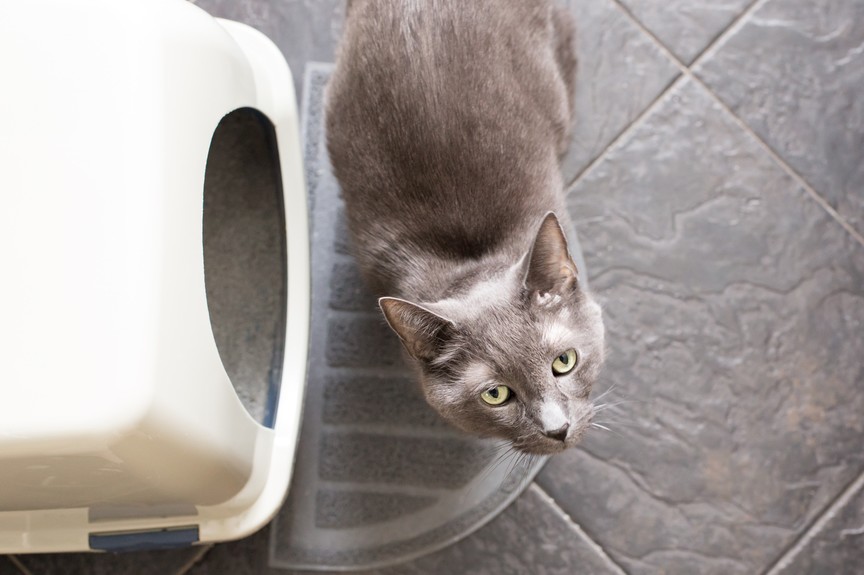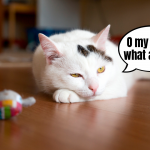The physiology of cats is complex, and this can easily be seen from their behaviour when using the litter tray, for example. Cats are very clean animals and are keen to use the designated, safe and comfortable place for their life’s needs. Therefore, if they occasionally get their needs outside the litter tray, any such behaviour always has its cause and is never caused by any malice on their part. They usually do so because of emotional or health problems. There can be a lot of stimuli for this type of behaviour and they can be really different. If the cat litter tray isn’t always the place where the cat empties out, this is a clear signal to us Carers to act quickly. Let’s help our cat and look for the causes of this unusual behaviour.
First of all, let us exclude health problems
Dear cats, health is paramount, so before you do anything about replacing the litter tray or litter tray, let’s first check that the problem with your cat’s handling is not caused by her illness. In this case, it could be a problem with your cat’s genitourinary system, but not only that. A visit to the vet and a basic check-up is the best start in our fight against this problem. If you notice any disturbing behaviour on the part of your pet, in addition to the tray, it is worth going to a specialist to determine the health of your pet. In such a situation, it is recommended to perform a clinical examination, a general urine test with sediment and protein/creatinine ratio, a urine bactericide test, blood and faeces tests. Before visiting the clinic, it is a good idea to call the clinic and ask how to prepare for such a test so as not to expose our cat’s friend to the stress of extra travel. For example, if you find out that you’re going to need a urine or faeces test, or that your cat is going to be on an empty stomach because she’s going to have blood drawn for the test, let’s get ready for it before the visit.
It is important to keep an eye on your cat at all times. It can happen that your cat is normally using the litter tray, but she will also be peeing outside it. This is a signal that she may have problems with stones in her urinary system. Such situations are dangerous for his health and we know this from our own experience with our cat Luis. You’d better not delay your visit to the vet then.
We’re unhooking your cat’s health and looking for more
If the tests have shown nothing to worry about and the cat is healthy, the problem is probably in her psyche. There are a number of important reasons for the cat to be dirty outside the litter tray and not be interested in it. The cat’s psyche – as all the Caretakers of these wonderful animals know – is a bottomless pit and a topic that is beyond the reach of the ordinary mortal. Cats are some of the more complex and emotionally sensitive animals, so our role in observing the cat and paying attention to its behaviour is important. So what are the reasons behind the cat’s aversion to the litter tray? The most common issues raised in this area are:
stress, which for a cat can mean a lot of situations like this: redecorating or renovating an apartment, moving house, a new home (whether in the form of a different fur or a less hairy version – a small child), leaving a companion “behind a rainbow bridge”, changing our rhythm of work and being with the cat (taking a new job, which requires us to stay away from home all day long when we were working from home), changes in our behaviour (we became physically or mentally ill), unknown noises from behind the wall, from a neighbouring balcony or window, a noisy neighbour, a new neighbour’s dog or cat, etc. As you can see, there can be many reasons for stress in our cat – the ground is to observe and seek the cause of this stress, and then eliminate it. Fortunately, this kind of elimination of the stress factor usually relieves us of the problem of getting our cat out of the litter tray;
a struggle for dominance between rival cats. Being even a pretty good observer of our cat friends, we may not see (or simply not understand) the relationship between our cats living together under one roof. Cats are emotional and character-rich animals, so their friendship or aversion can have completely different faces, and the tiny subtleties woven between playing or lying down together can deceive us and our vigilance. It is sometimes the case that cats living under the same roof can officially tolerate each other and everything from the outside looks fine. But under the so-called coat shavings fly, claws tear and fangs fly. Such rivalry does not have to have an outlet in domestic battles, but it can be hidden from our human eye and manifest itself in the fact that a cat that feels dominated in this relationship is not using the litter tray. Fear of a terrorist companion causes the cat to wander in search of a place to quietly settle its physiological needs. And here again, our watchful observation becomes invaluable. If necessary, you can use the services of a cat’s behaviourist, which we highly recommend to everyone;
- the older the cat, the more likely it is to have incontinence problems;
2. the litter tray and related topics, like:
the wrong number of trays in the apartment – very often one in the house is not enough, especially when there are more purrings. In this case it is a good idea to increase the number of places and thus the number of trays where cats can do their physiological work,
incorrect placement of the litter tray – it’s a good idea to give your cat a sense of intimacy and put her toilet in such a place that no one or anything can ‘get in the way’ of her affairs. The location of the cat litter tray should give your cat cover on one side and an opportunity to observe the environment on the other. If your cat’s home is two floors or more, it’s a good idea to have a litter tray on each level (of course we don’t go crazy, because if your cat is using one tray and has no problem getting things done in other places, don’t make the house a cat’s toilet:),
Tray size – the vast majority of trays are unfortunately too small because the cat should be able to enter and turn around freely in the tray, which is not always possible. We know that a cat litter tray, as it is not very ‘attractive’ because of the function for which it is designed, is usually placed out of the reach of human eyes and away from the most often besieged parts of the house. We also try to make sure it doesn’t take up too much space with its dimensions. However, it is worth buying one that gives your cat freedom of movement. It is enough for us to put ourselves in a cat’s situation of tightness and lack of space for free movement during such an important and repeated activities up to several times a day… None of us would like such inconveniences, believe us that our cat too:),
the type of tray – open or closed – depends a lot on the cat itself, because both have their advantages. The most important thing is that the cat feels free and safe in the tray. If we have a small kitten, it is easier to get used to the type that suits us better. It can happen that your cat doesn’t respond in the litter tray of your choice and won’t want to look into it. This is then the easiest problem to solve, because we just have to buy another one:)
Gravel – choosing a litter tray is also your cat’s choice, although your kitten can get used to the kind of litter tray her little companion has chosen. There are cats that will easily accept any kind of litter, and there are cats that won’t be suitable for the type, size, smell or texture of the litter. From the technical advice we can suggest that the litter poured into a container should reach up to 5 cm. Cats like to clean up their droppings properly – after all, they’re exemplary cleaners – and there’s nothing to limit their enjoyment. But if we want to introduce a new litter to the cat’s toilet, it is worth to do it gradually, mixing first a smaller part of it with the old litter, and with time adding more and more of it – until the success, i.e. a complete change. As you can see, patience works in every field for cats:);
Cleaning the cat litter tray and adding litter is one of our most important duties. For a cat who appreciates clean paws and fur and devotes as much time to their care as he does to eating and playing, it’s very important that when entering the litter tray, what he left behind before doesn’t greet him good morning. We also flush the toilet after every visit, why should it be different for a cat?:)
How to take care of the tray?
Selecting and adapting the tray to the needs of the cat is the first thing. The second one is its cleaning, care and regular cleaning – unfortunately, it won’t get over itself, and even if it’s ‘self-cleaning’, without our intervention from time to time, the content along with used litter will not disappear as if by magic wand… it’s a pity:) If we neglect our “tray” duties, it may happen that we come across such a cat “surprise egg” somewhere in our house. It is worth to choose feces at least twice a day, preferably in the morning and evening. This is such an absolute minimum, especially with a few cats, which is worth keeping to. A shoulder blade is helpful in removing faeces from the litter tray, which can often be bought together with the litter tray. When choosing a shoulder blade, it is good to pay attention to its meshes, and exactly whether they will be adjusted in size to the gravel we intend to use. For example, natural gravel is usually cylindrical in shape and not all the blades are able to simply sift it. Larger pieces (clodded faeces) are removed with a shoulder blade with holes to sift clean gravel. The shoulder blade should be stored next to the tray for convenience and speed, but not very pleasant for us.
As far as cleaning the tray is concerned, boiling water works great here – it is effective, it handles well even with dried dirt and we do not leave any chemicals in the tray. We pour the tray and spatula with this kind of boiling water and we’re done! That’s why it is also important for us to know what kind of plastic the tray is made of so that the plastic is not too soft and does not deform when exposed to high temperatures. We also pay attention to the simplicity of the shape – you know – the less nooks and crannies the easier it is to wash the cuvette thoroughly.
How do you teach your cat to use the tray?
Knowing where to get your needs done is not difficult for a bearded four-legged cat to learn. Your cat’s physiology doesn’t keep any big secrets from her, especially if she has been raised by a domesticated cat. As a rule of thumb it is enough to show her where her private toilet is. It is worse if the cat’s litter tray is something new and alien to her. In this case, learning can take a little longer. It’s a good idea to put your cat in the litter tray regularly and patiently and then praise, praise and praise her again when she uses it properly (treats are perfect for this role). Any punishment for unsuccessful attempts to use the litter tray is totally out of the question but we know that you – dear cats, we don’t have to write about such obviousness:)
Getting your cat out of the litter tray is obviously a huge problem for his Guardians. Fortunately, in most cases it can be solved. Sometimes it takes some effort – to find the source of this unusual behaviour and apply the right therapy. However, if our kitten cannot use the litter tray because she hasn’t had a chance to acquire this skill so far, it’s enough to teach her purring Friend this art patiently and not pushyly. We are convinced that as soon as she feels the gravel between her claws, the “mining” instincts will be immediately involved in her:)
Our pets are pure animals by nature, if you can put it that way, and the predispositions to deal with the cat’s toilet are in their genes. And fortunately they do! Thanks to this, we can enjoy their company, friendship and couch lifestyle, without having to lead them to this huge toilet, to which all the Dog Guardians go (whom we love and greet:)
And how do you take over these trays? Do you have any of your tray patents? Such knowledge will be useful for every cat, and even more so for the new Cat Keeper. We look forward to hearing from you!




